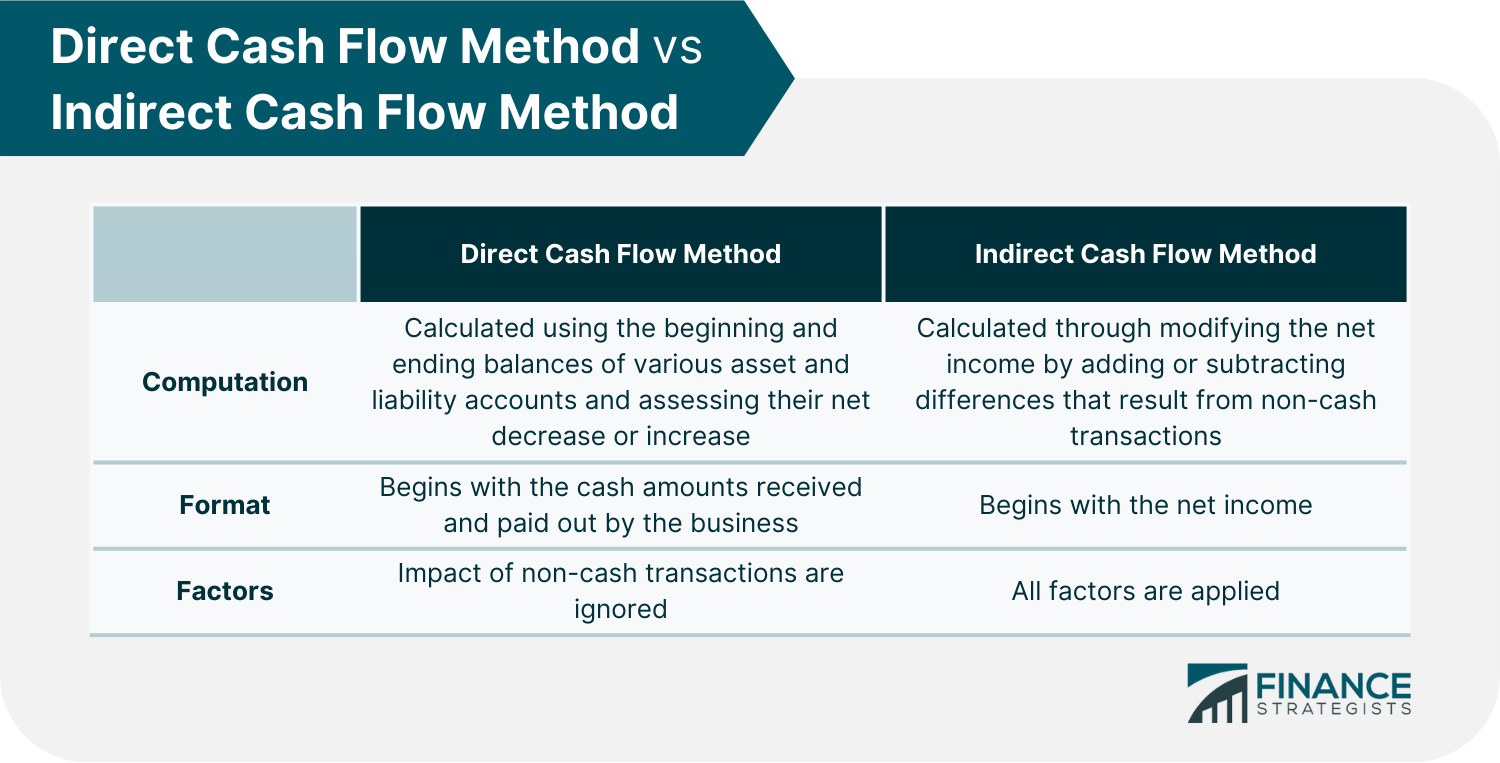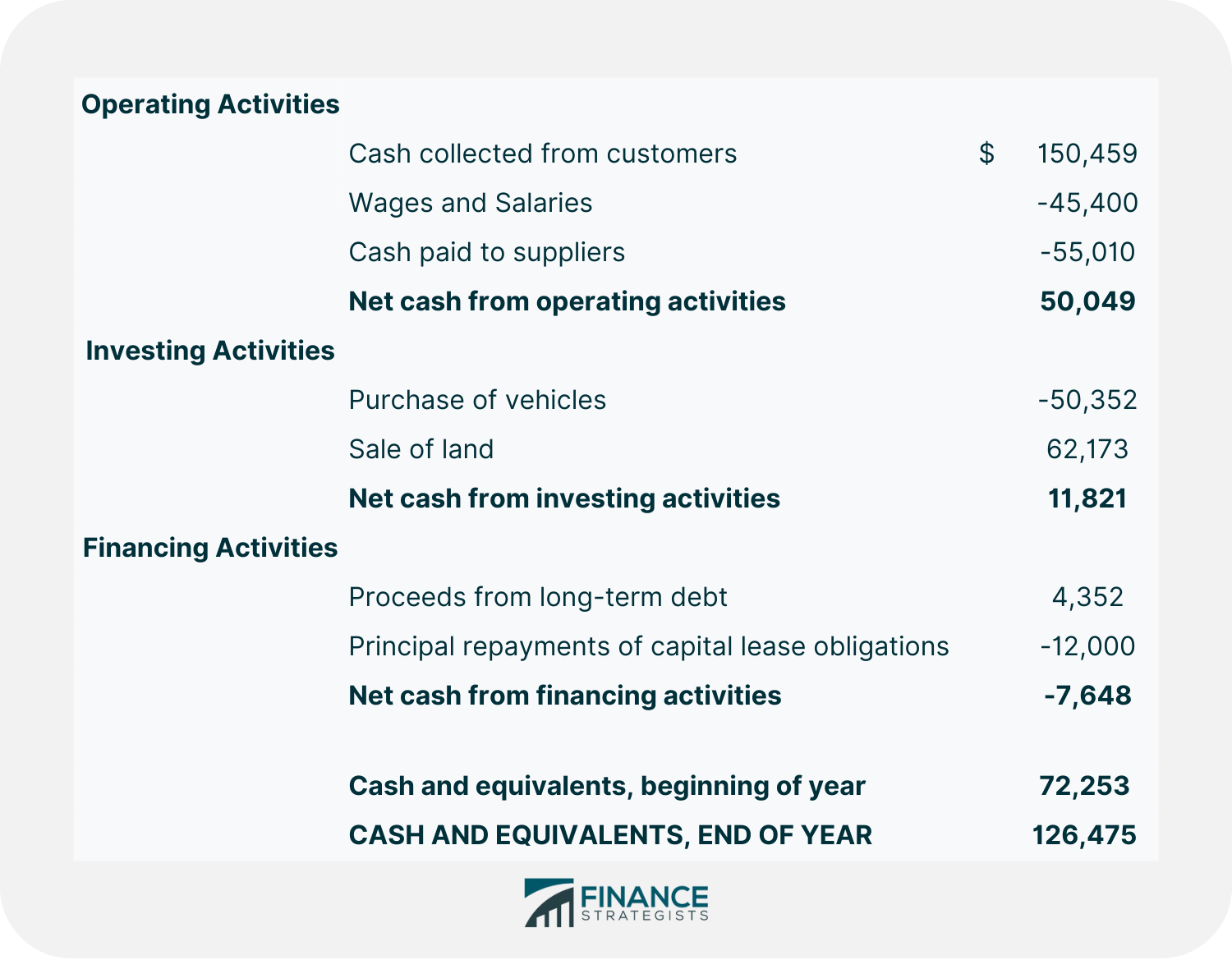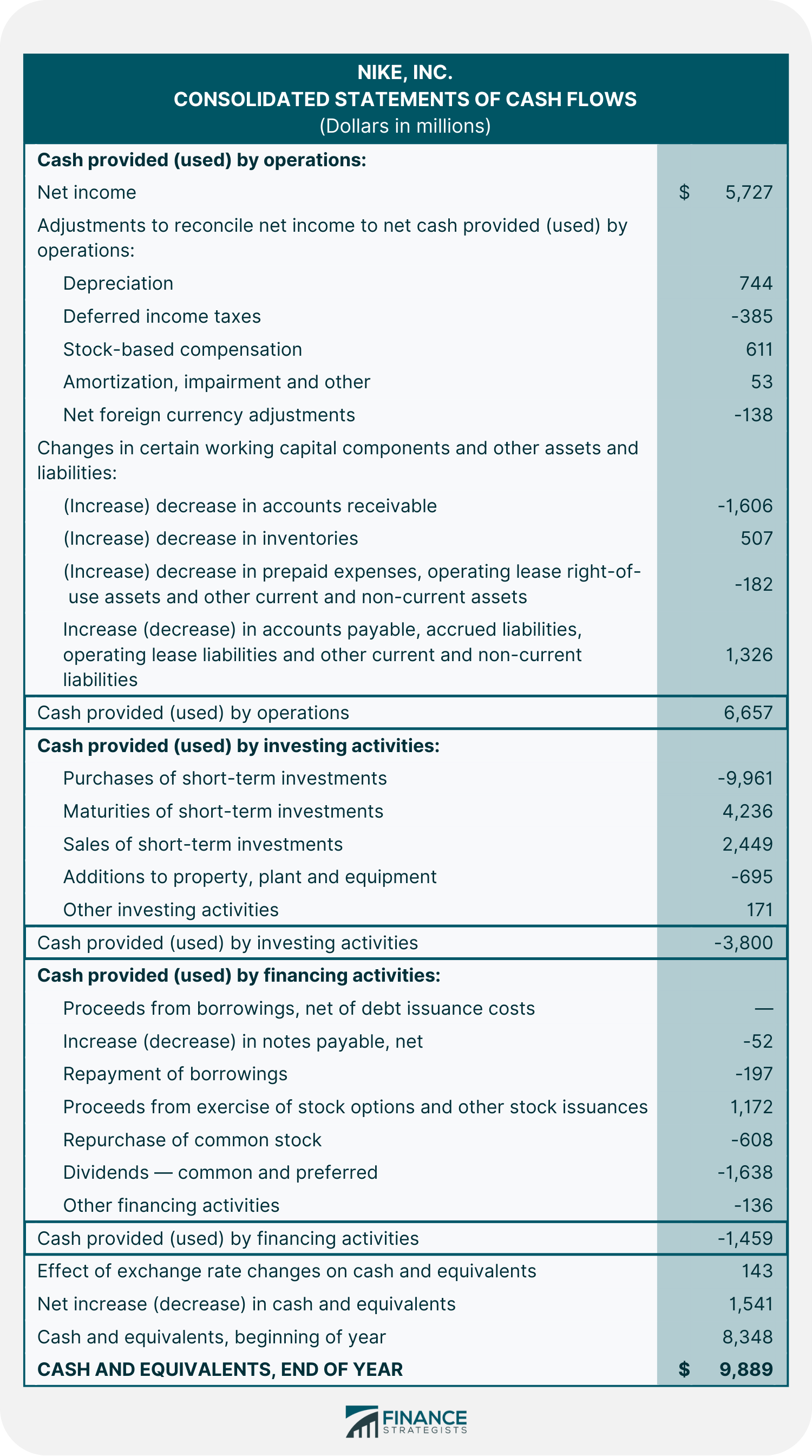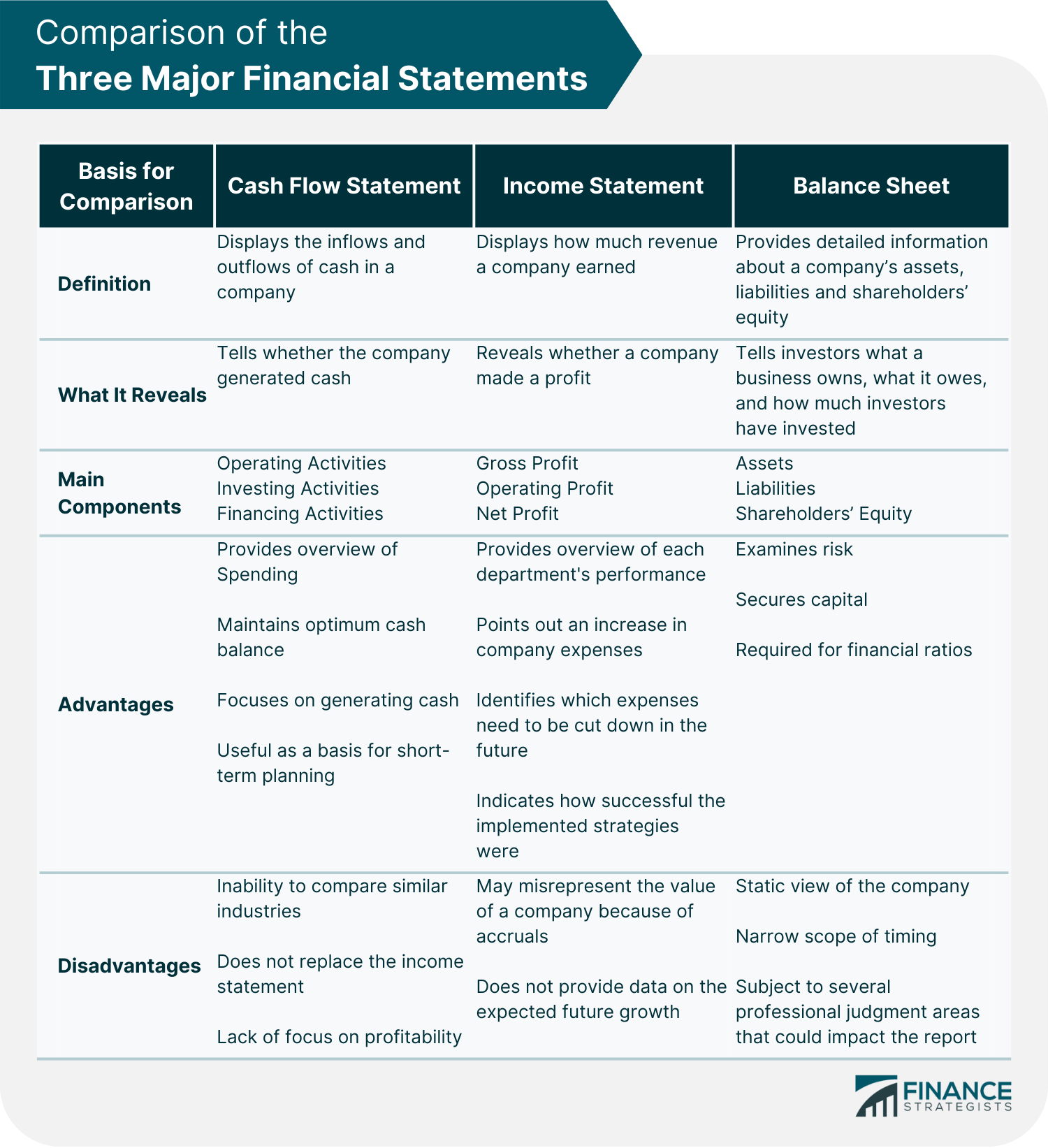

A cash flow statement (CFS) is a financial statement that captures how much cash is generated and utilized by a company or business in a specific time period.
By looking at the cash flow statement, one can see whether the company has sufficient cash flowing in to pay its debts, fund its operations, and return money to shareholders via dividends or stock buybacks.
CFS bridges the income statement and balance sheet because it shows how money moves in and out of the business via three main channels: operating, investing, and financing activities.
It produces what is called the net cash flow by breaking down where the changes in the beginning and ending balances came from.
The cash flow statement is focused on the cash accounting method, which means that business transactions reflect in the financial statement when the cash flows into or out of the business or when actual payments are received or distributed.

To present a clearer picture of the two methods, there are some examples presented below.
An example of the cash flow statement using the direct method for a hypothetical company is shown here:

In the above example, the business has net cash of $50,049 from its operating activities and $11,821 from its investing activities. It has a net outflow of cash, which amounts to $7,648 from its financing activities.
As a result, the business has a total of $126,475 in net cash flow at the end of the year.
This is another example of a cash flow statement of Nike, Inc. using the indirect method for the fiscal year ending May 31, 2021.

This cash flow statement shows that Nike started the year with approximately $8.3 million in cash and equivalents.
The business brought in $6.65 million through its operating activities. Meanwhile, it spent approximately $3.8 million in investment activities, and a further $1.45 million in financing activities.
The changes in the value of cash balance due to fluctuations in foreign currency exchange rates amount to $143 million.
Consequently, the business ended the year with a positive cash flow of $1.5 million and total cash of $9.88 million.
The CFS is one of the most important financial statements for a business. Cash is the lifeblood of any organization, and a company needs to have a good handle on its cash inflows and outflows in order to stay afloat.
There are several reasons why the cash flow statement is so important:
The cash flow statement presents a good overview of the company’s spending because it captures all the cash that comes in and goes out.
This information is helpful so that management can make decisions on where to cut costs. It also helps investors and creditors assess the financial health of the company.
Another important function of the cash flow statement is that it helps a business maintain an optimum cash balance.
Management can use the information in the statement to decide when to invest or pay off debts because it shows how much cash is available at any given time.
The cash flow statement also encourages management to focus on generating cash.
This is because when a company knows where its cash is going, it can take steps to make sure that more cash is coming in than going out.
A cash flow statement is an important measurement because it provides information that can be used to make short-term plans.
For instance, if a company realizes that it will have a cash shortfall in the next month, it can take steps to ensure enough funds are available.
The Cash Flow Statement has a few limitations:
The cash flow statement is useful when analyzing changes in cash flow from one period to the next as it gives investors an idea of how the company is performing.
However, it does not measure the efficiency of the business in comparison to a similar industry. This is because terms of sales and purchases may differ from company to company.
Other companies may also have a higher capital investment which means they have more cash outflow rather than cash inflow.
The cash flow statement does not replace the income statement as it only focuses on changes in cash. In contrast, the income statement is important as it provides information about the profitability of a company.
The cash flow statement will not present the net income of a company for the accounting period as it does not include non-cash items which are considered by the income statement.
Therefore, it does not evaluate the profitability of a company as it does not consider all costs or revenues.
Three financial statements provide insights into the financial performance of a company and potential issues that may need to be addressed: the income statement, balance sheet, and cash flow statement.
These three documents offer unique information that serves as the foundation of corporate accounting.
Below is a comparison between cash flow statement, income statement, and balance sheet:

The cash flow statement is an essential financial statement for any business as it provides critical information regarding cash inflows and outflows of the company.
It helps businesses to make crucial decisions about spending, investments, and credit.
Cash flow statements display the beginning and ending cash balances over a specific time period and points out where the changes came from (i.e operating activities, investing activities, and financing activities).
This information allows businesses to forecast future cash needs, make informed investment decisions, and track actual performance against budgeted targets.
However, the cash flow statement also has a few limitations, such as its inability to compare similar industries and its lack of focus on profitability.
Therefore, it should always be used in unison with the income statement and balance sheet to get a complete financial overview of the company.
Positive cash flow reveals that more cash is coming into the company than going out. This is a good sign as it tells that the company is able to pay off its debts and obligations. Negative cash flow typically shows that more cash is leaving the company than coming in, which can be a reason for concern as the company may not be able to meet its financial obligations in the future. However, this could also mean that a company is investing or expanding which requires it to spend some of its funds.
Direct cash flow statements show the actual cash inflows and outflows from each operating, investing, and financing activity. While the indirect cash flow method makes adjustments on net income to account for accrual transactions.
Cash flow statements are important as they provide critical information about the cash inflows and outflows of the company. This information is important in making crucial decisions about spending, investments, and credit.
The main components of a cash flow statement are cash flows from operating activities, investing activities, and financing activities.
Cash flow is the total amount of cash that is flowing in and out of the company. Free cash flow is the available cash after subtracting capital expenditures.

About the Author
True Tamplin is a published author, public speaker, CEO of UpDigital, and founder of Finance Strategists.
True is a Certified Educator in Personal Finance (CEPF®), author of The Handy Financial Ratios Guide, a member of the Society for Advancing Business Editing and Writing, contributes to his financial education site, Finance Strategists, and has spoken to various financial communities such as the CFA Institute, as well as university students like his Alma mater, Biola University, where he received a bachelor of science in business and data analytics.
To learn more about True, visit his personal website or view his author profiles on Amazon, Nasdaq and Forbes.

WHY WE RECOMMEND:
Fee-only financial advisors are paid a set fee for their services. They do not receive any type of commission from the sale of products they are advising on.
Retirees, Immigrants & Sudden Wealth / Inheritance
Retirement Planning, Personal finance, Goals-based Planning & Community Impact

WHY WE RECOMMEND:
Fee-only financial advisors are paid a set fee for their services. They do not receive any type of commission from the sale of products they are advising on.
Business Owners, Executives & Medical Professionals
Strategic Planning, Alternative Investments, Stock Options & Wealth Preservation
Finance Strategists has an advertising relationship with some of the companies included on this website. We may earn a commission when you click on a link or make a purchase through the links on our site. All of our content is based on objective analysis, and the opinions are our own.
Content sponsored by 11 Financial LLC. 11 Financial is a registered investment adviser located in Lufkin, Texas. 11 Financial may only transact business in those states in which it is registered, or qualifies for an exemption or exclusion from registration requirements. 11 Financial’s website is limited to the dissemination of general information pertaining to its advisory services, together with access to additional investment-related information, publications, and links.
For information pertaining to the registration status of 11 Financial, please contact the state securities regulators for those states in which 11 Financial maintains a registration filing. A copy of 11 Financial’s current written disclosure statement discussing 11 Financial’s business operations, services, and fees is available at the SEC’s investment adviser public information website – www.adviserinfo.sec.gov or from 11 Financial upon written request.
11 Financial does not make any representations or warranties as to the accuracy, timeliness, suitability, completeness, or relevance of any information prepared by any unaffiliated third party, whether linked to 11 Financial’s website or incorporated herein, and takes no responsibility therefor. The articles and research support materials available on this site are educational and are not intended to be investment or tax advice. All such information is provided solely for convenience purposes only and all users thereof should be guided accordingly.
© 2024 Finance Strategists. All rights reserved.
We use cookies to ensure that we give you the best experience on our website. If you continue to use this site we will assume that you are happy with it.